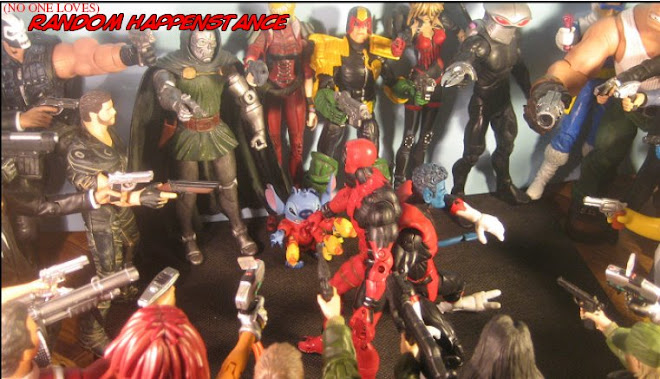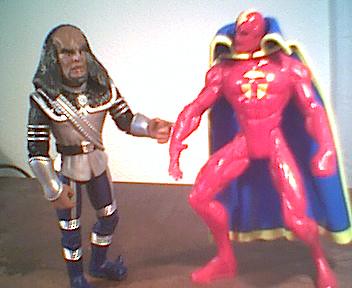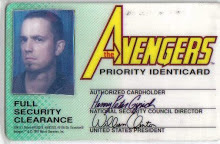
Weird. I had originally intended for this to be one of my first posts, but couldn't get the picture to load, then lost it and had to retype it. I also have better Worf and Red Tornado figures, but these were the ones I found first. The Worf was a promo from a retail convention, and Red was from the JLA/Total Justice line. But what do they have in common? Well, let's see.
Like many geeks, I watched Star Trek: the Next Generation devotedly when it first aired; then again in syndication. Repeatedly. Like an old photo handled, passed around, and left out in the light for years; Next Generation is starting to show its age a bit. Some of the effects seem dated, the early uniforms seem retro; and plotlines were used, reused, then used some more. The reuse may not necessarily have been by Trek, but the plots still wear out. The first season looked dated after the second season, which didn't help.
Anyway, my friend Christian Hemion (I want him to get credit for this!) pointed this out pretty early on: Worf is a badass. Even with horrible, horrible hair and drinking prune juice, Worf was Trek's designated asskicker for years. Which lead to a problem, not with Worf per se, but dramatic shorthand, or lazy writing.
Problem: when introducing the threat or villain of the week, the writers may only have a limited amount of time to show how or why it is a threat. How can you make this hypothetical villain tough? Well, in the old Star Trek, the monster of the week would start by wiping out a few security officers, the Redshirts. By the time of TNG, this was a fondly remembered but nonetheless terrible cliche, so something new was needed. It seems the answer was, have the new villain kick the tar out of Worf.
"Wow, that guy must be super tough! He messed Worf up!" By itself, nothing should be wrong with that. After all, while Worf was established as a formidable fighter, he wasn't invulnerable or unstoppable.
The trouble is, when you pull that trick more than once or twice, Worf starts to seem less hardass, more handed his ass. A character that was once respected can become a laughing stock. So, Christian's term for this writing shortcut was Worf Syndrome: to make a newly introduced villain or character more formidable, have them beat the toughest character in your regular cast.
By no means is this a new idea, just a convenient name to hang on it. For another example, in old Justice League of America comics, Red Tornado would take the Worf role. Now, for those who may not be familiar with him, Red Tornado was an android with wind related powers. He was a nice enough sort, not very Worf-like as a character: he was never portrayed as extra-tough or formidable, and was strictly b-list. And he regularly got beaten by the villain of the month, early on, to show the bad guy meant business. Red even had moments where he seemed to realize he was being 'jobbed out,' as the wrestling fans would say. Then he would try to collect himself, shake it off, and try again...and get smacked.
Even in the Justice League Unlimited cartoon, Red ended up in the same role: he was lasered apart by Amazo in one episode. Why? Because as a robotic character, he blows up real good. And as a robot, he was not only more repairable/expendable than other, "human" characters, but it's a great visual. When Despero or Chemo or Sinestro (love the O Squad!) blast Green Arrow with a particle beam, it strains credibility if he's not disintegrated. So, blast Red Tornado! He's a robot, he can take it and be repaired next month for more abuse.
Even in recent issues of Justice, Red gets taken apart, and Alex Ross even sticks with the old school, dated technology look for Red's innards. For a highly sophisticated, sentient and emotional android with superpowers; he looks about as high-end as a Maskatron action figure from the seventies. (If you get that reference, congratulations! You're old. Yeah, I know, my back's killing me too.)
Red also served to correct a weakness in the formula of the old Justice League stories: when the bad guy is established by taking Superman down in the first four pages, kids will have a hard time believing Snapper Carr is going to save the day. (More than once, anyway.) So, the seventies plot formula was closer to: Bad guy appears, has plan, wallops Red Tornado, moves plan into action, JLA regroups, cleans bad guy's clock. Repeat.
Strangely, Red Tornado seems like a singular example of "Robot Whipping Boy." The Vision never had to put up with that in Marvel's Avengers. (Until Byrne or Bendis, anyway...) I think Christian also pointed out to me Spartan from early issues of Jim Lee's WildC.A.T.'s (Last time I try to put the periods in that. I think I've read like one issue ever.) Spartan was also an android/synthezoid/bolt-necked automaton. I thought it would be a great idea, if they treated him as a completely disposable teammate, which they may have at some point. I know some more backstory was added later, that Spartan had the downloaded soul or personality of somebody or other. I don't care, and neither should the team. A typical exchange should go something like this:
Midget guy Emp ducks behind a wall, laser blasts flying around him, cigar clenched in his teeth, gun in hand. Very Nick Fury, if Fury was three feet tall.
EMP: Damn! Helspont or Flamer or whatever his name is has us pinned down! Spartan!
SPARTAN: (Saluting) Sir Yes Sir!
EMP: Get out there and draw his fire!
SPARTAN: Sir Yes---(Takes energy blasts to head, chest, groin) SQUAWK!
EMP: Goddammit. Warblade!
WARBLADE: (from way, way off panel) What?
EMP: Start up a new Spartan! Right now!
WARBLADE: Oh, c'mon! I just got that one to stop blinking 12:00!
I'm pretty sure Voodoo was using the Spartans as, bluntly, sex toys as well. But that's neither here nor there. To give Christian a last bit of credit, he thought it would be hilarious if Patrick Stewart's Picard treated Data like that, yelling at him and calling him robot in a thick British accent.
Wow, way off topic now. Anyway, the basic point is just to look at dramatic shorthand. You can probably think of some others, and we may hit some more, like plot recaps or Claremontisms or getting knocked unconscious. The question then becomes, how much shorthand can you see before the illusion of story falls apart?
Sunday, June 18, 2006
Worf had assumed that all androids would play pull my finger.
Subscribe to:
Post Comments (Atom)



No comments:
Post a Comment